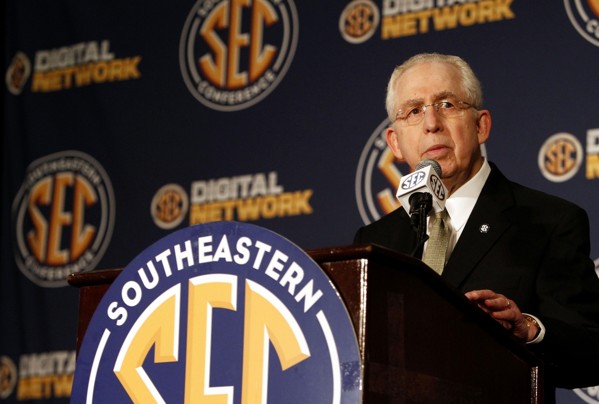More TV Money for the Nation’s Most Powerful Conference: Surprise, Surprise…
Posted by Chris Johnson on May 3rd, 2013Chris Johnson is an RTC Columnist. He can be reached @ChrisDJohnsonn.
Because once-meaningful concepts like academic and cultural similarity, geographical proximity and longstanding tradition no longer control how or why college athletic conferences exist, and because television, you know, does – Thursday’s news out of SEC headquarters is a very big deal, both for league directly involved, the SEC, along with every other college sports conference. The South Eastern Conference announced a 20-year agreement with ESPN Thursday to air a 24/7 all-encompassing sports network beginning in 2014, with programming that includes 45 football games and more than 100 men’s basketball games annually, plus “selected events” from non-revenue sports and other important offseason dates such as football pro-days and national signing day.

An expansive new TV contract will grow the SEC’s already monumental annual financial take (AP Photo).
This is a very big deal. It is not mars-landing breaking news. Here’s why: the SEC exists in an entirely different plane of football competitiveness and import, stuffed to the hilt with NFL-bound talent and a fervent pigskin culture not seen in any other league across the country, but they were a step or two behind on this conference-specific television fad. The Big Ten and Pac-12 networks already have their own networks, which promise (alongside nonstop league-centric coverage) exorbitant annual sums, serve to expand the otherwise lesser profile of lower-tier programs and clearly represent the way of the future in a bountiful college sports television frontier.
The more subscribers there are in different regions of the country, the more fans that are eager to watch Washington State play Utah on a Thursday night, for example, the more money falls into league coffers and the more other schools – we’re looking at you, AAC – want a piece of the pie. These were the logistical league-hopping dynamics behind much of the recent conference realignment wave (go watch Maryland’s astonishingly candid introductory Big Ten press conference), and they will continue to drive the ship in league membership decisions, even if the ACC’s recent grant of rights deal appears to have ensured at least temporary realignment calm among the major conferences.
The SEC didn’t consummate its deal with an eye towards realignment. Commissioner Mike Slive isn’t looking to make his league more attractive by formalizing some splashy broadcast figures; he’s doing it because the SEC is unfathomably popular, and no matter how much the statutory paradigms of college athletics are subverted and warped over the next ten or so years, or what damage Ed O’Bannon’s lawsuit may or may not wreak on the NCAA’s amateuristic economic restrictions, that unbridled pride isn’t going away. The southern part of the United States is smitten by campus ardor and almost obligatory built-in football watching customs, all of which will, under every circumstance, survive the length of this contract. The SEC already earns roughly 14 million per year from its contracts with ESPN and CBS, but over the past few years the Big Ten and Pac-12 had eclipsed the SEC in annual television revenues.
That dynamic had to change – not just because the SEC is to the rest of major college sports what “Big Brother” is to George Orwell’s mythical 1984 dystopian society, but for the sheer purpose of taking back the next most important thing existing in college sports: television revenue. The SEC knew it had the support, the infrastructure and the deep-pocketed alumni base to sustain a galaxy-sized sports entity. Finally landing the television contract to encapsulate that value, inquantifiable though it may be, was less a real question than a mere eventuality.
I guess the other item of importance is the boost in non-football coverage, and how an all-day SEC-only stream could push the meter in promoting the league’s non-UK basketball cachet. The SEC was ugly to watch last season, intolerable to the point where, if given the choice, you’d have gladly picked a MAC or Big Sky game instead. Ok, it wasn’t that bad, and Kentucky very well may put the SEC back on the map this year with another national title, but the crux of this contract, of every major college sports television deal, is about football – and the SEC always wins with football. That’s really what this boils down to: winning, monetarily.
For SEC-hoops enthusiasts, the best hope is for a gradual by-osmosis attraction, whereby football hawks become so accustomed to flipping on their favorite league’s network that the Monday night Texas A&M-Mississippi State becomes an impulsive, even if totally passive or unintentional, viewing option. The SEC won because it always wins, on the field or in the administrative department or in the NFL teams it annually enhances with its highly-recruited brand of college stars each season. Hoops will, or should, reap the residual benefit. Quality of play aside, more college basketball on more television sets can’t be a bad thing.
This is good, right, I mean, it should be.












































